Mises, Ludwig von. Human Action: A Treatise on Economics
Подождите немного. Документ загружается.

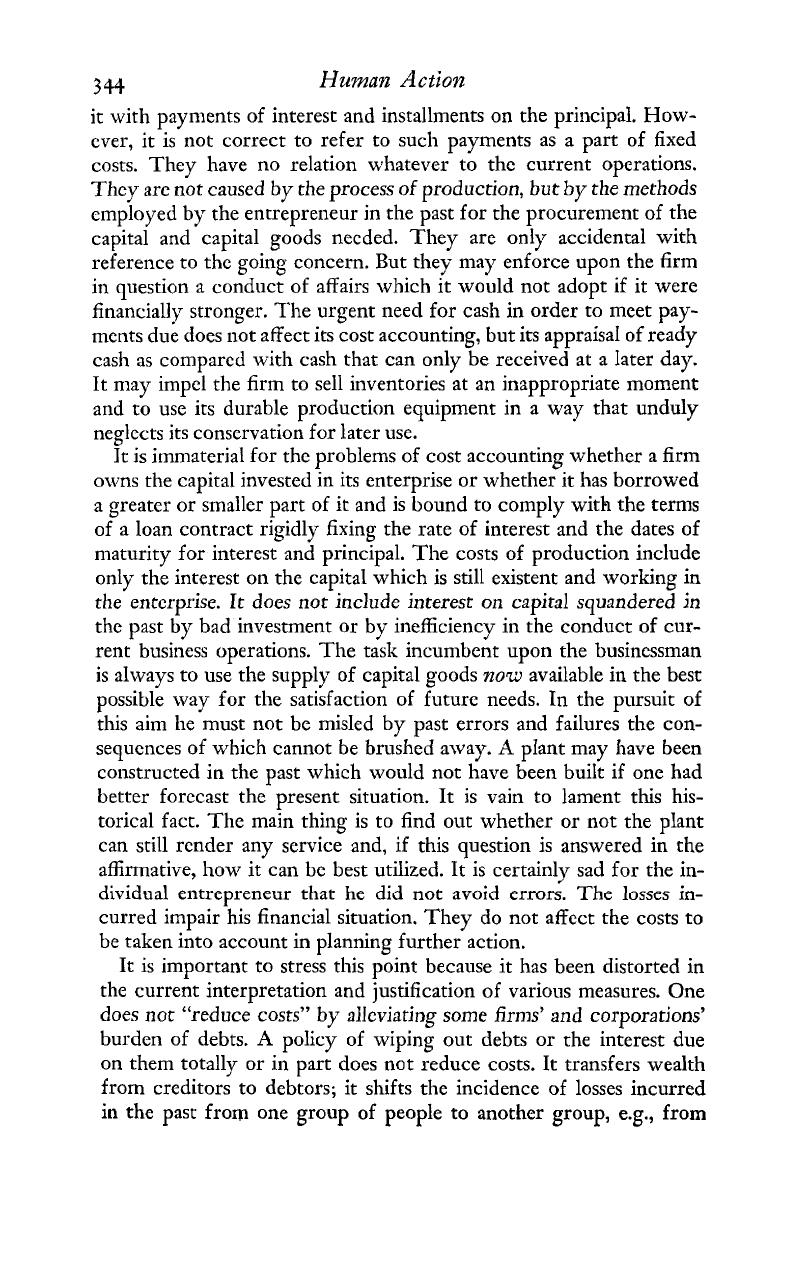
3
44
Human
Action
it with payments of interest and installments on the principal. How-
ever, it is not correct to refer to such payments as a part of fixed
costs. They have no relation whatever
to
the current operations.
They are not caused by the process of production, but
by
the
methods
employed by the entrepreneur in the past for the procurement of the
capital and capital goods needed. They are only accidental with
reference to the going concern. But they may enforce upon the
firm
in question a conduct of affairs which it would not adopt if it were
financially stronger. The urgent need for cash in order to meet pay-
ments due does not affect its cost accounting, but its appraisal of ready
cash as compared w-it11 cash that can only be received at a later day.
It may impel the firm to sell inventories at an inappropriate moment
and to use its durable production equipment in a way that unduly
neglects its conservation for later use.
It is immaterial for the problems of cost accounting whether a firm
owns the capital invested in its enterprise or whether it has borrowed
a greater or smaller part of
it
and is bound to comply with the terms
of a loan contract rigidly fixing the rate of interest and the dates of
maturity for interest and principal. The costs of production include
only the interest on the capital which is still existent and working in
the enterprise. It does not include interest on capital squandered
jn
the past by bad investment or by inefficiency in the conduct of cur-
rent business operations. The task incumbent upon the businessman
is always to use the supply of capital goods
now
available in the best
possible way for the satisfaction of future needs.
In
the pursuit of
this aim he must not be misled by past errors and failures the con-
sequences of which cannot be brushed away.
A
plant may have been
constructed
in
the past which would not have been built if one had
better forecast the present situation. It is vain to lament this his-
torical fact. The main thing is to find out whether or not the plant
can still render any service and, if this question is answered in the
affirmative, hour it can be best utilized. It is certainly sad for the in-
dividual entrepreneur that he did not avoid errors. The losses in-
curred impair his financial situation. They do not affect the costs to
be taken into account in planning further action.
It is important to stress this point because it has been distorted in
the current interpretation and justification of various measures. One
does not '%educe costs" by alleviating some firms' and corporations'
burden of debts.
A
policy of wiping out debts or the interest due
on them totally or in part does not reduce costs. It transfers wealth
from creditors to debtors; it shifts the incidence of losses incurred
in
the past from one group of people to another group, e.g., from
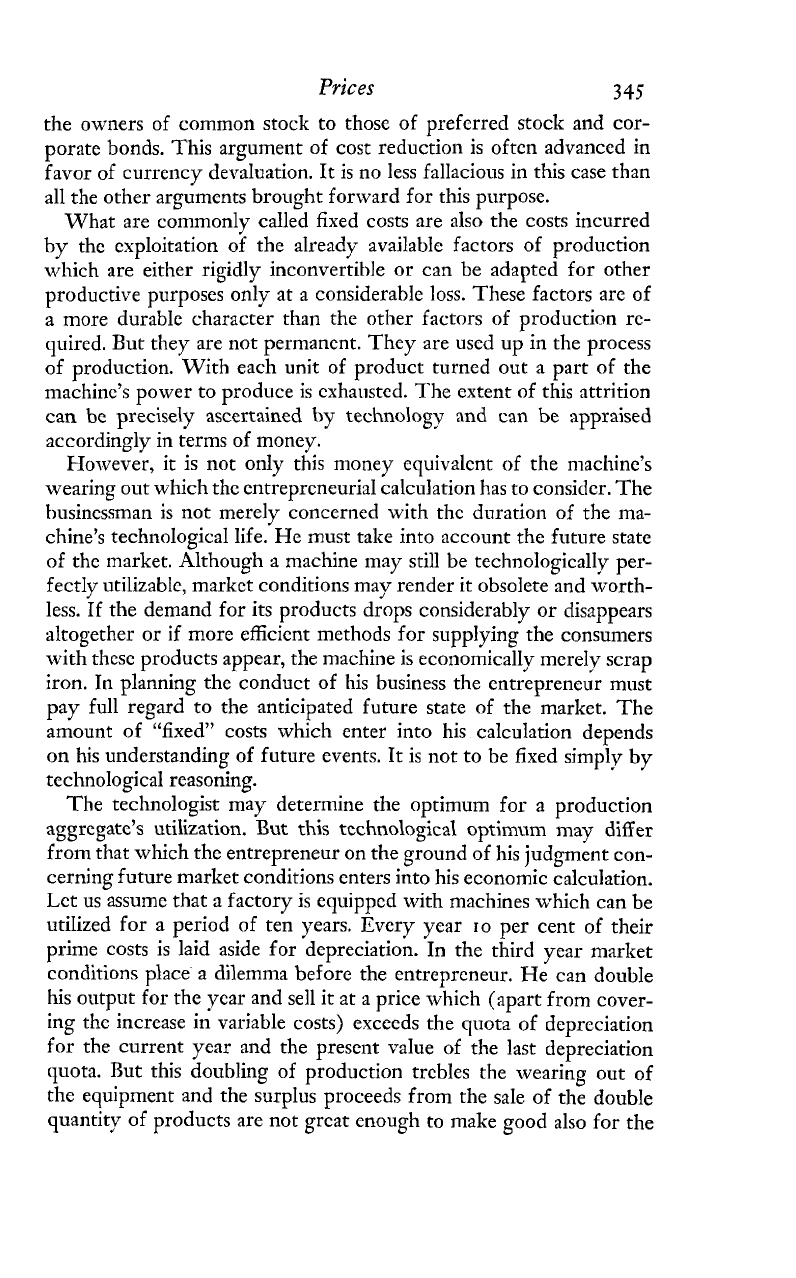
Prices
345
the owners of common stock to those of preferred stock and cor-
porate bonds. This argument of cost reduction is often advanced in
favor of currency devaluation. It is no less fallacious in this case than
all the other arguments brought forward for this purpose.
What are commonly called fixed costs are also the costs incurred
by the exploitation of the already available factors of production
which are either rigidly inconvertihle or can be adapted for other
productive purposes only at a considerable loss. These factors are of
a more durable character than the other factors of production re-
quired. But they are not permanent. They are used up in the process
of production. With each unit of product turned out a part of the
n~achine's power to produce is cxhausted. 'The extent of this attrition
can be precisely ascertained
by
technology and can be appraised
accordingly in terms of money.
However,
it
is not only this money equivalent
of
the machine's
wearing out which the entrepreneurial calculation has to consider. The
t)usinessman is not merely concerned with thc duration of the ma-
chine's technological life. He must take into account the future state
of the market. Although a machine may still be technologically per-
fectly utilizable, market conditions may render it obsolete and worth-
less. If the demand for its products drops considerably or disappears
altogether or if more efficient methods for supplying the consumers
with these products appear, the machine is economically merely scrap
iron. In planning the conduct of his business the entrepreneur must
pay full regard to the anticipated future state of the market. The
amount of "fixed" costs which enter into his calculation depends
on his understanding of future events.
It
is not to be fixed simply by
technological reasoning.
The technologist may determine the optimum for a production
aggregate's utilization. But this technological optimum may differ
from that which the entrepreneur on the ground of his judgment con-
cerning future market conditions enters into his economic calculation.
Let us assume that
a
factory is equipped with machines which can be
utilized for a period of ten years. Every year ro per cent of their
prime costs is laid aside for depreciation. In the third year market
conditions place a dilemma before the entrepreneur. He can double
his output for the year and sell it at a price which (apart from cover-
ing the increase id variable costs) exceeds the quota of depreciation
for the current year and the present value of the last depreciation
quota. But this doubling of production trebles the wearing out of
the equipment and the surplus proceeds from the saIe of the double
quantity of products are not great enough to make good also for the
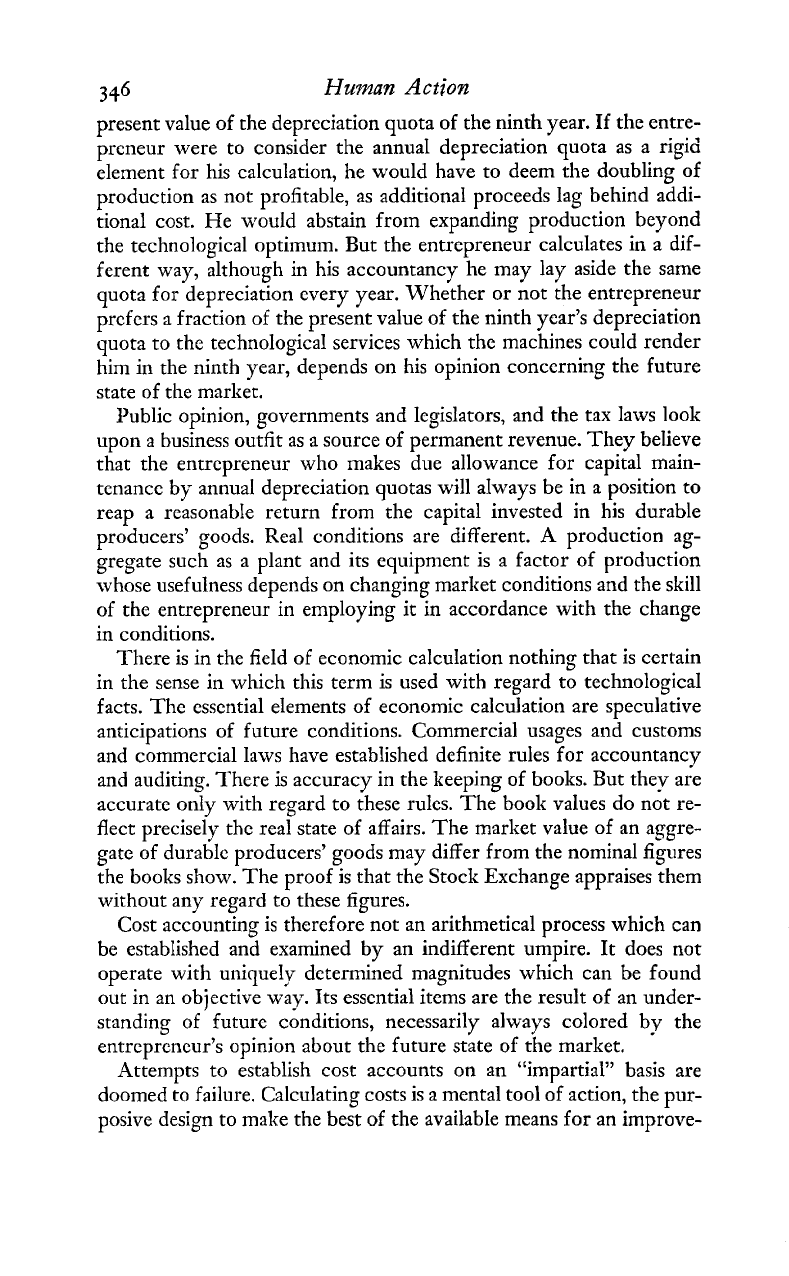
346
Human Action
present value of the depreciation quota of the ninth year. If the entre-
preneur were to consider the annuaI depreciation quota as a rigid
element for his calculation, he would have to deem the doubling of
production as not profitable, as additional proceeds lag behind addi-
tional cost. He would abstain from expanding production beyond
the technological optimum. But the entrepreneur calculates in a dif-
ferent way, although in his accountancy he may lay aside the same
quota for depreciation every year. Whether or not the entrcpreneur
prefers a fraction of the present value of the ninth year's depreciation
quota to the technological services which the machines could render
him in the ninth year, depends on his opinion concerning the future
state of the market.
Public opinion, governments and legislators, and the tax laws look
upon a business outfit as a source of permanent revenue. They believe
that the entrcpreneur who makes due allowance for capital main-
tenance by annual depreciation quotas will aIways be in a position to
reap a reasonable return from the capital invested in his durable
producers' goods. Real conditions are different. A production ag-
gregate such as a plant and its equipment is a factor of production
whose usefulness depends on changing marltet conditions and the skill
of the entrepreneur in employing it in accordance with the change
in conditions.
There is in the field of economic calculation nothing that is certain
in the sense in which this term is used with regard to technological
facts. The esscntial elements of economic calculation are speculative
anticipations of future conditions. Commercial usages and customs
and commercial laws have established definite rules for accountancy
and auditing. There is accuracy in the keeping of books. But they are
accurate only with regard to these rules. The book values do not re-
flect precisely the real state of affairs. The market value of an aggre-
gate of durable producers' goods may differ from the nominal figures
the books show. The proof is that the Stock Exchange appraises them
without any regard to these figures.
Cost accounting is therefore not an arithmetical process which can
be estabIished and examined by an indifferent umpire. It does not
operate w-ith uniquely determined magnitudes which can be found
out in an objective way. Its esscntial items are the result of an under-
standing of future conditions, necessarily always colored
by
the
entrepreneur's opinion about the future state of the market.
Attempts to establish cost accounts on an "impartial" basis are
doomed to failure. Calculating costs is a mental tool of action, the pur-
posive design to make the best of the available means for an improve-

Prices
347
ment of future conditions. It is necessarily volitional, not factual. In
the hands of an indifferent umpire it changes its character entirely.
The umpire does not look forward to the future. He looks backward
to the dead past and to rigid rules which are useless for real life and
action. He does not anticipate changes. He is unwittingly guided by
the prepossession that the evenly rotating economy is the normal and
most desirable state of human affairs. Profits do not
fit
into his scheme.
He has a confused idea about a "fair" rate of profit or a "fair" return
on capital invested. However, there are no such things. In the evenly
rotating economy there are no profits. In a changing economy profits
are not determined with reference to any set of rules by which they
could be classified as fair or unfair. Profits are never normal. Where
there is normality, i.e., absence of change, no profits can emerge.
5.
Logical Catallactics Versus Mathematical Catallactics
The problems of prices and costs have been treated also with
mathematical methods. There have even been economists who held
that the only appropriate method of dealing with economic problems
is the mathematical method and who derided the logical economists
as "literary" economists.
If this antagonism between the logical and the mathematical econo-
mists were merely a disagreement concerning the most adequate
procedure to be applied in the study of economics, it would be
superfluous to pay attention to it. The better method would prove
its preeminence by bringing about better results. It may also be that
different varieties of procedure are necessary for the solution of
different problems and that for some of them one method is more
useful than the other.
However, this is not a dispute about heuristic questions, but a con-
troversy concerning the foundations of economics. The mathematical
method must be rejected not only on account of its barrenness. It is
an
entirely
vicious merhod, srarring from fake assumptions and iead-
ing to fallacious inferences. Its syllogisms are not only sterile; they
divert the mind from the study of the real problems and distort the
relations between the various phenomena.
The ideas and procedures of the mathematical economists are not
uniform. There are three main currents of thought which must be
dealt with separately.
The first variety is represented by the statisticians who aim at
discovering economic laws from the study of economic experience.
I'hey aiin to transform economics into a "quantitative" science. Their

program is condensed in the motto of the Econometric Society:
Science is measurement.
The fundamental error implied in this reasoning has been shown
above.i Experience of economic history is always experience of com-
plex phenomena. It can never convey knowledge of the kind the
experimenter abstracts from a laboratory experiment. Statistics is a
method for the presentation of historical facts concerning prices
and other relevant data of human action. It is not economics and can-
not produce economic theorems and theories. The statistics of prices
is economic history. The insight that,
ceteris paribus,
an increase
in demand must result in an increase in prices is not derived from
experience. Kobody ever was or ever will be in a position to ob-
serve a change in one of the market data
ceteris paribus.
There is
no such thing as quantitative economics. All economic quantities we
know about are data of economic history. No reasonable man can
contend that the relations between price and supply is in general,
or in respect of certain commodities, constant. We know, on the
contrary, that external phenomena affect different people in differ-
ent ways, that the reactions of the same people to the same external
events vary, and that it is not possible to assign individuals to classes
of men reacting in the same way. This insight is a product of our
aprioristic theory. It is true the empiricists reject this theory; they
pretend that they aim to learn only frorn historical experience. How-
ever, they contradict their own principles as soon as they pass be-
yond the unadulterated recording of individual single prices and
begin to construct series and to compute averages. A datum of ex-
perience and a statistical fact is only a price paid at a definite time
and
a
definite place for a definite quantity of a certain commodity.
The
arrangement of various price data in groups and the computation
of averages are guided by theoretical deliberations which are logically
and temporally antecedent. The extent to which certain attending
features and circumstantial contingencies of the price data concerned
are
cake~i
or
not
taken inco consideration depends on theoreticai
reasoning of the same kind. Nobody is so bold as to maintain that a
rise of
a
per cent in the supply of any commodity must always-in
every country and at any time-result in a fall of
b
per cent in its
price. But as no quantitative econon~ist ever ventured to define pre-
cisely on the ground of statistical experience the spcciaI conditions
producing a definite deviation from the ratio
a
:
b,
the futilitv of his
endeavors is manifest. Moreover, money is not
a
standard 'for the
nxasurcment of prices; it is a medium whose exchange ratio varies
7.
Cf.
above,
pp.
31,
55-56,
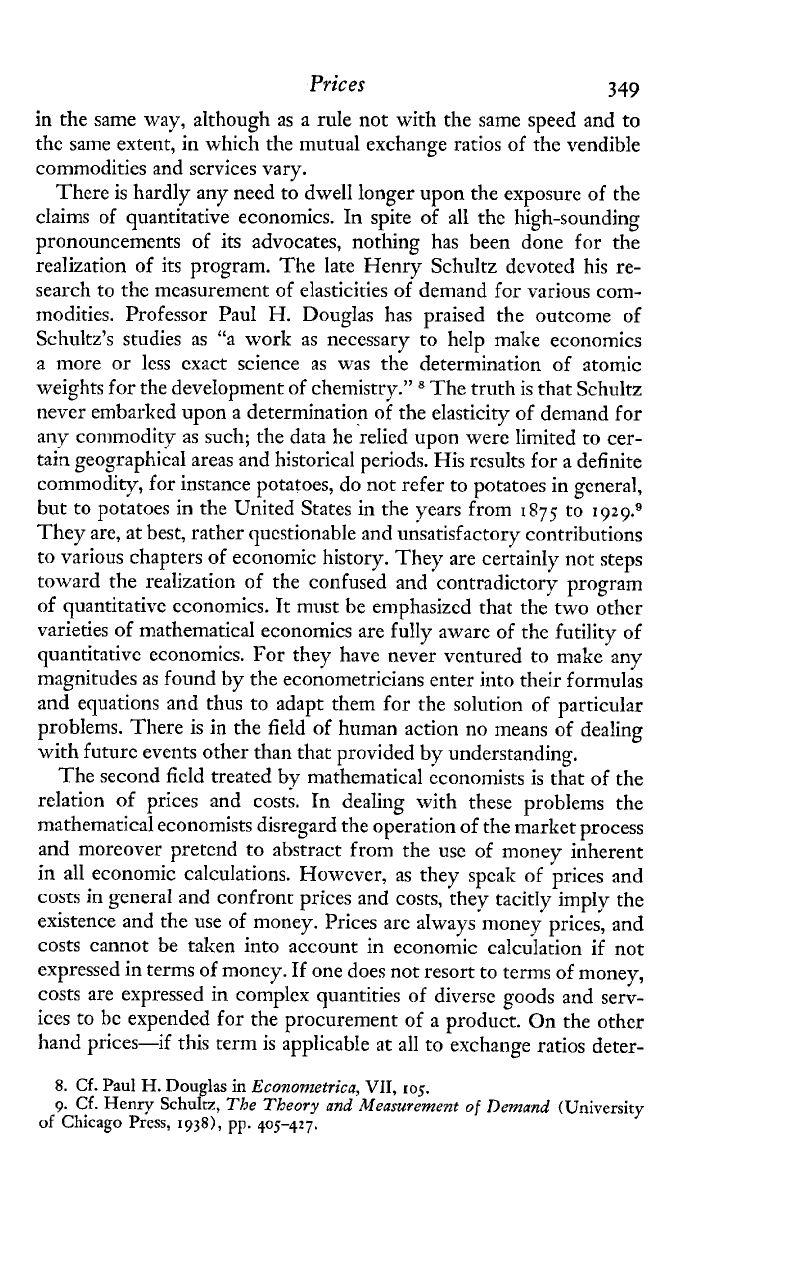
Prices
349
in the same way, although as a rule not with the same speed and to
the same extent, in which the mutual exchange ratios of the vendible
-
commodities and services vary.
There is hardly any need to dwelI longer upon the exposure of the
claims of quantitative economics. In spite of all the high-sounding
pronouncements of its advocates, nothing has been done for the
realization of its program. The late Henry Schultz devoted his re-
search to the measurement of elasticities of demand for various com-
modities. Professor Paul
H.
Douglas has praised the outcome of
Schultz's studies as "a work as necessary to help make economics
a more or less exact science as was the determination of atomic
weights for the development of chemistry." The truth is that Schultz
never embarked upon a determination of the elasticity of demand for
any commodity as such; the data he relied upon were limited to cer-
tain geographical areas and historical periods. His results for a definite
commodity, for instance potatoes, do not refer to potatoes in general,
but to potatoes in the United States in the years from
1875
to
1929.~
They are, at best, rather questionable and unsatisfactory contributions
to various chapters of economic history. They are certainly not steps
toward the realization of the confused and contradictory program
of quantitative economics. It must be emphasized that the two other
varieties of mathematical economics are fully aware of the futility of
quantitative economics. For they have never ventured to make any
magnitudes as found by the econometricians enter into their formulas
and equations and thus to adapt them for the solution of particular
problems. There is in the field of human action no means of dealing
with future events other than that provided by understanding.
The second field treated by mathematical economists is that of the
rclation of prices and costs.
In
dealing with these problems the
mathematical economists disregard the operation of the market process
and moreover pretend to abstract from the use of money inherent
in all econonlic calculations. However, as they speak of prices and
costs in generai and confront prices and costs, they tacitiy impiy the
existence and the use of money. Prices are always money prices, and
costs cannot be taken into account in economic calculation if not
expressed in terms of money. If one does not resort to terms of money,
costs are expressed in complex quantities of diverse goods and serv-
ices to he expended for the procurement of a product. On the other
hand prices-if this term is applicabIe
at
all to exchange ratios deter-
8.
Cf.
Paul
H.
Douglas
in
Econometrics,
VII,
tor.
9.
Cf.
Henry
Schultz,
The Theory
and
Measurement
of
Demmnd
(University
of
Chicago
Press,
19381,
pp.
405-427,
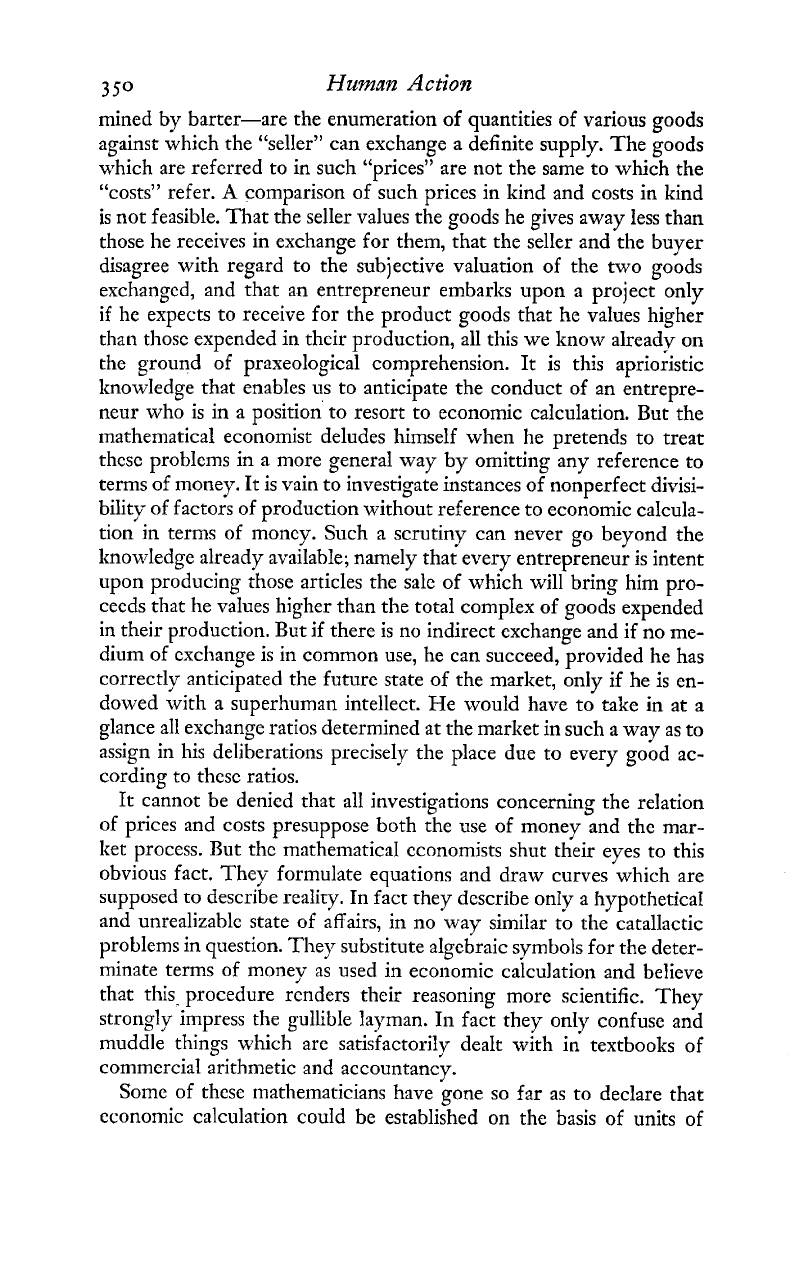
3
50
Human
Action
mined by barter-are the enumeration of quantities of various goods
against which the "seller"
can
exchange
a
definite supply. The goods
which are referred to in such "prices" are not the same to which the
"costs" refer.
A
comparison of such prices in kind and costs in kind
is not feasible. That the seller values the goods he gives away less than
those he receives in exchange for them, that the seller and the buyer
disagree with regard to the subjective valuation of the two goods
exchangcd, and that an entrepreneur embarks upon a project only
if
he expects to receive for the product goods that he values higher
than those expended in their production, all this we know alreadv on
the ground of praxeological comprehension. It is this aprio;istic
know-ledge that enables us to anticipate the conduct of an entrepre-
neur who is in
a
position to resort to economic calculation. But the
~nathematical economist deludes himself when he pretends to treat
thcsc problems in a more general way by omitting any reference to
terms of money. It is vain to investigate instances of nonperfect divisi-
bility of factors of production without reference to economic calcula-
tion in terms of money. Such a scrutiny can never go beyond the
knowledge already available; namely tha; every entrepreneur is intent
upon producing those articles the sale of which will bring him pro-
ceeds that he values higher than the total complex of goods expended
in their production. But if there is no indirect exchange and if no me-
dium of cxchange is in common use, he can succeed, provided he has
correctly anticipated the future state of the market, only if he is en-
dowed with a superhuman intellect. He would have to take in at a
glance all exchange ratios determined at the market in such a way as to
assign in his deliberations precisely the place due to every good ac-
cording to these ratios.
It
cannot be denied that all investigations concerning the relation
of prices and costs presuppose both the use of money and the mar-
ket process. But the mathematical economists shut their eyes to this
obvious fact. They formulate equations and draw curves which are
supposed ro describe reaiiry. in fact they describe oniy a hypothetical
and unrealizablc state of affairs, in no way similar to the catallactic
problems in question. They substitute algebraic symbols for the deter-
minate terms of money as used in economic calculation and believe
that this- procedure rcnders their reasoning more scientific. They
strongly impress the gullible layman.
In
fact they only confuse and
muddle things which are satisfactorily dealt with in textbooks of
commercial arithmetic and accountancy.
Some of thcsc mathematicians have gone so far as to declare that
economic calculation could be established on the basis of units of
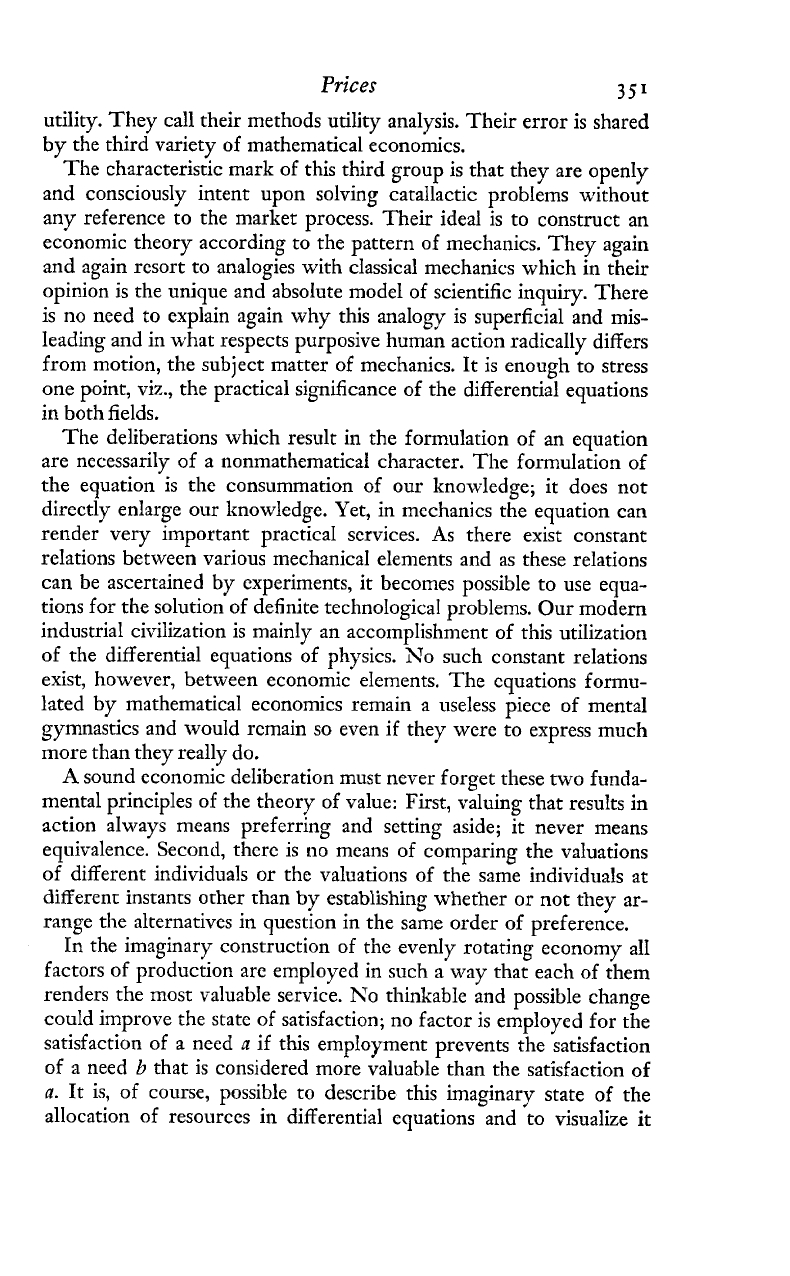
Prices
351
utility. They call their methods utility analysis. Their error is shared
by the third variety of mathematical economics.
The characteristic mark of this third group is that they are openly
and consciously intent upon solving catallactic problems without
any reference to the market process. Their ideal is to construct an
economic theory according to the pattern of mechanics. They again
and again resort to analogies with classical mechanics which in their
opinion is the unique and absolute model of scientific inquiry. There
is no need to explain again why this analogy is superficial and mis-
leading and in what respects purposive human action radically differs
from motion, the subject matter of mechanics. It is enough to stress
one point, viz., the practical significance of the differential equations
in both fields.
The deliberations which result in the formulation of an equation
are necessarily of a nonmathematical character. The formulation of
the equation is the consummation of our knowledge; it does not
directly enlarge our knowledge. Yet, in mechanics the equation can
render very important practical services. As there exist constant
relations between various mechanical elements and as these relations
can be ascertained by experiments, it becomes possible to use equa-
tions for the solution of definite technological problems. Our modern
industrial civilization is mainly an accomplishment of this utilization
of the differential equations of physics. No such constant relations
exist, however, between economic elements. The equations formu-
lated by mathematical economics remain a useless piece of mental
gymnastics and would remain so even if they were to express much
more than they really do.
A
sound economic deliberation must never forget these two funda-
mental principles of the theory of value: First, valuing that results
in
action always means preferring and setting aside; it never means
equivalence. Second, there is no means of comparing the valuations
of different individuals or the valuations of the same individuals at
diEerent instants other than by estabiisiiing whether or not they ar-
range the alternatives in question in the same order of preference.
In the imaginary construction of the evenly rotating economy all
factors of production are employed in such a way that each of them
renders the most valuable service. No thinkable and possible change
could improve the state of satisfaction; no factor is employed for the
satisfaction of
a
need
a
if this employment prevents the satisfaction
of a need
b
that is considered more valuable than the satisfaction of
a.
It is, of course, possible to describe this imaginary state of the
allocation of resources in differential equations and to visualize it

3
52
Human
Action
graphically in curves. But such devices do not assert anything about
the market process. They mereIy mark out an imaginary situation in
which the market process would cease to operate. The mathematical
economists disregard the whole theoretical elucidation of the market
process and evasively amuse themselves with an auxiliary notion
employed in its context and devoid of any sense when used outside
of this context.
In physics we are faced with changes occurring in various sense
phenomena. We discover a regularity in the sequence of these changes
and these observations lead us to the construction of a science of
physics. We know nothing about the ultimate forces actuating these
changes. They are for the searching rnind ultimately given and defy
any further analysis. What we know from observation is the regular
concatenation of various observable entities and attributes. It is this
mutual interdependence
of
data that the physicist describes in
dif-
ferential equations.
In praxeology the first fact we know is that men are purposively
intent upon bringing about some changes. It
is
this Itnowled, <re that
integrates the subject matter of praxeology and differentiates it from
the subject matter of the natural sciences. We know the forces behind
the changes, and this aprioristic knowledge leads us to a cognition of
the praxeological processes. The physicist does not know what
electricitv "is." I-Ic knows only phenomena attributed to something
called electricity. But the economist knows what actuates the market
process. It is only thanks to this ltnowlcdge that he is in a position to
distinguish market phenomena from other phenomena and to describe
the market process.
Now,
the mathematical economists does not contribute anything
to the elucidation
of
the market process. Hc mercly describes an
auxiliary makeshift employed by the logical economists as a limiting
notion, the definition of a state of affairs in which there is no longer
any action and the market process has come to a standstiI1. That is
all he can sav. -W-hat the iogicai economist sets forth in words when
defining the- imaginary constructions of the final state of rest and
the evenly rotating economy and what the mathematical economist
himself must describe in words before he embarks upon his mathe-
matical work, is translated into algebraic symbols.
A
superficial anal-
ogy is spun out too long, that is alI.
Both the logical and the mathematical economists assert that human
action ultimately aims at the establishment of such a state of equilib-
rium and would reach it if all further changes in data were to cease.
But the logical economist knows much more than that.
Me
shows how
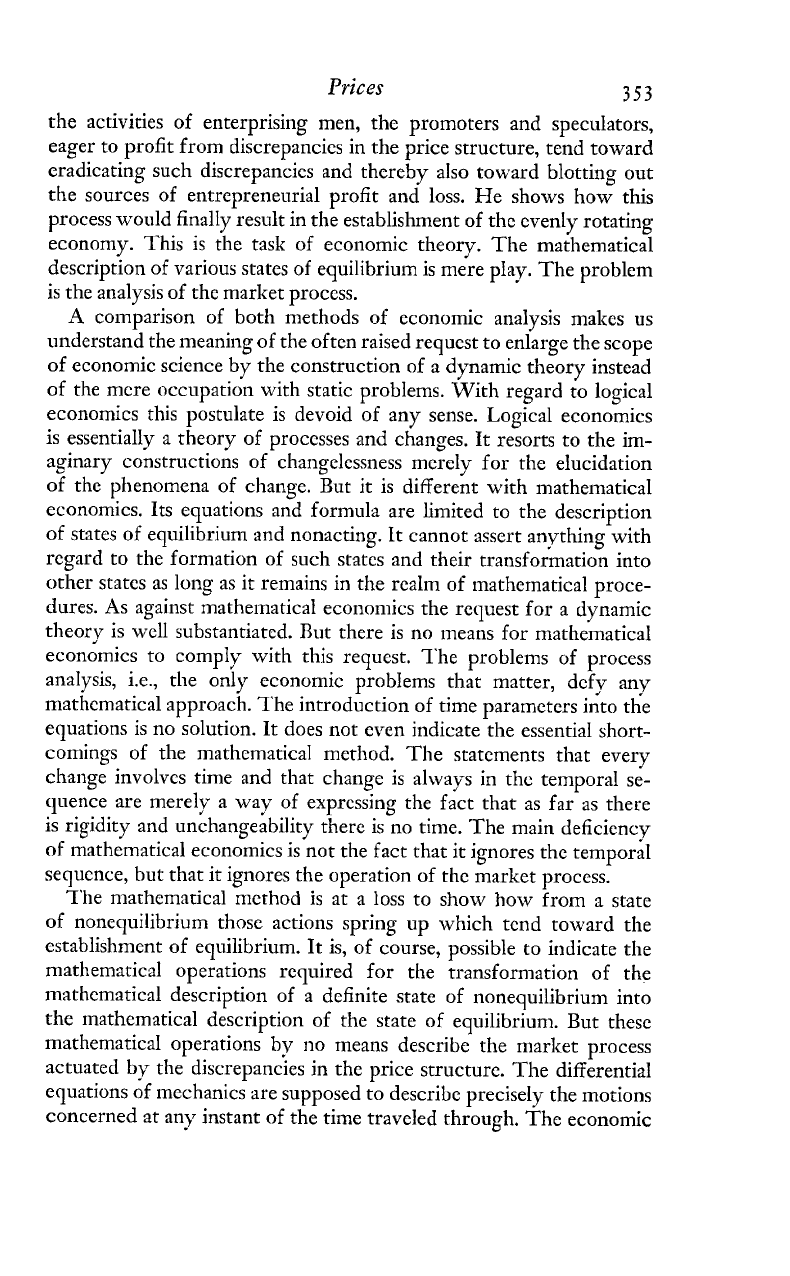
Prices
353
the activities of enterprising men, the promoters and speculators,
eager to profit from discrepancics in the price structure, tend toward
eradicating such discrepancies and thcreby also toward blotting out
the sources of entrepreneurial profit and loss. He shows how this
process would finally result in the establishment of the cvenly rotating
economy. This is the task of economic theory. The mathematical
description of various states of equilibrium is mere play. The problem
is the analysis of the market process.
A
comparison of both methods of economic analysis makes us
understand the meaning of the often raised request to enlarge the scope
of economic science by the construction of a dynamic theory instead
of the mcre occupation with static problems. With regard to logical
economics this postulate is devoid of any sense. Logical economics
is essentially a theory of processes and changes. It resorts to the im-
aginary constructions of changelessness mcrely for the elucidation
of the phenomena of change. But it is different with mathematical
economics. Its equations and formula are limited to the description
of states of equilibrium and nonacting. It cannot assert anything with
rcgard to the formation of such states and their transformation into
other states as long as it remains in the realm of mathematical proce-
dures. As against mathematical econon~ics the request for a dynamic
theory is well substantiated. But there is no means for mathematical
economics to comply with this request. The problems of process
analysis, i.e., the only economic problems that matter, defy any
mathematical approach. The introduction of time parameters into the
equations is no solution. It does not even indicate the essential short-
comings of the mathematical method. The statements that every
change involves time and that change is always in thc temporal se-
quence are merely a way of expressing the fact that as far as there
is rigidity and unchangeability there is no time. The main deficiency
of
mathematical economics is not the fact that it ignores thc temporal
sequence, but that it ignores the operation of the market process.
The mathematicai nlethod is at a ioss to show
Row
from a state
of nonequilibrium those actions spring up which tend toward the
cstablishmcnt of equilibrium. It is, of course, possible to indicate the
mathematical operations required for the transformation of the
mathematical description of a definite state of nonequilibrium into
the ~nathematical description of the state of equilibrium. But these
mathematical operations by no means describe the market process
actuated by the discrepancies
in
the price structure. The differential
equations of mechanics are supposed to describe precisely the motions
concerned at any instant of the time traveled through. The economic
